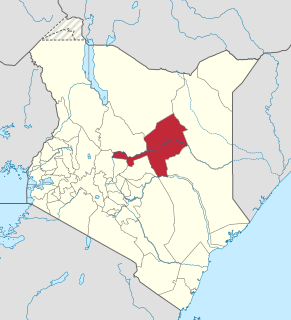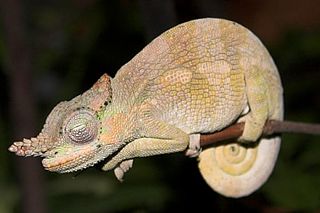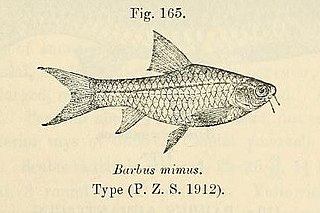
The Samburu National Reserve is a game reserve on the banks of the Ewaso Ng'iro river in Kenya. On the other side of the river is the Buffalo Springs National Reserve. The park is 165 km² in size and is situated 350 kilometers from Nairobi. It ranges in altitude from 800 to 1230m above sea level. Geographically, it is located in Samburu County.

Nyahururu is a town in Kenya, lying north east of Nakuru. The town derives its name from the Maasai word e-naiwurruwurr, meaning waterfall and/or windy or place of storms. It is located in Laikipia County. Despite this, Nyahururu formerly functioned as the administrative capital of Nyandarua County, before it became a county, until the headquarters was shifted to Ol Kalou. There have been calls for a reversal. The town has an urban population of 36,450. The town still continues to be a central economic power of the immediate former district of Nyandarua. For that reason, the town has strong economic ties to the two counties.

The Aberdare Range is a 160 km long mountain range of upland, north of Kenya's capital Nairobi with an average elevation of 3,500 metres (11,480 ft). It is located in Nyandarua County, west central Kenya, northeast of Naivasha and Gilgil and just south of the Equator. The mountain range is called Nyandarua among the Agikuyu people in whose territory this forest and mountain range is located. The name Nyandarua means a drying hide due to the distinctive fold of its silhouette.

The singing bush lark is a species of lark found in Africa, the Middle East, and South Asia.

Isiolo County is a county in the former Eastern Province of Kenya. Its population is 268,002 and its capital is Isiolo. Isiolo County is to be the first county to be developed as part of the Kenya Vision 2030 program. Its capital and largest town is Isiolo. Other upcoming urban centres are: Garbatulla, Modogashe, Kinna, Merti and Oldonyiro.

Kinyongia is a chameleon genus recently established for several plesiomorphic species found in forest and woodland in Kenya, Tanzania, Uganda, Rwanda, and far eastern DR Congo. All except K. adolfifriderici and K. tavetana are restricted to highlands, and many have very small geographic ranges. In most, at least the males have horns or knobs on their noses. They had been placed into the genus Bradypodion for some time. It has recently been pointed out that the ending to the specific epithet in several of the below listed species should be modified to match the feminine genus name.

Ewaso Ny'iro is a river in Kenya which rises on the west side of Mount Kenya and flows north then east and finally south-east, passing through Somalia where it joins the Jubba River. The upper basin of the Ewaso Ng'iro River is 15,200-square-kilometre (5,900 sq mi). The river has a continuous water supply due to the glaciers on Mount Kenya. Ewaso Ng'iro feeds into Lake Ol Bolossat, the only lake in Nyandarua county and the larger Central Kenya. Ewaso Ng'iro crosses seven arid to semi-arid landscapes. It is characterized by vastly different physiographic features and species and has become a fundamental component to the survival of the wildlife, as well as the expansion of human population and socio-economic developments. Water, the limited land resource provided by the Ewaso Ng’iro watershed is unevenly distributed throughout the higher and lower regions of the catchment due to the large percentage necessary to maintain agricultural practices and climatic changes.

The Ewaso Nyiro barb is a species of ray-finned fish in the family Cyprinidae.

The Ewaso Nyiro labeo is an African species of freshwater fish in the family Cyprinidae. It is found only in Kenya. Its natural habitat is rivers.

Chiloglanis is a genus of upside-down catfishes native to Africa. These species have modified lips and barbels that form a suckermouth. They also have a naked (scaleless) body. Sexual dimorphism has been reported in Chiloglanis. The adult males of many of these species have elongate anal and caudal fins. Also, males may have an enlarged humeral process.
Chiloglanis sp. nov. 'Kerio' is a species of fish in the family Mochokidae. It is endemic to Kenya. Its natural habitat is rivers.
The Boji Plains nothobranch is a species of fish in the family Nothobranchiidae, endemic to the drainage of the Ewaso Nyiro in Kenya. Its natural habitat is intermittent freshwater marshes.

Chiloglanis cameronensis is a species of upside-down catfish native to Cameroon, Equatorial Guinea and Gabon where they are found in the coastal rivers. This species grows to a length of 5.5 centimetres (2.2 in) TL.
Chiloglanis fasciatus, the Okavango suckermouth, is a species of upside-down catfish native to Angola, Botswana and Namibia where it is found in the Kwando River and the Okavango River and Delta. This species grows to a length of 6.4 centimetres (2.5 in) TL.

Buffalo Springs National Reserve is a protected area in the Isiolo County in northern Kenya.
The Ewaso Lions Project was founded in 2007 for the protection of lions and their habitat in Northern Kenya. The project works to study and incorporate local communities in helping to protect the lions in the Samburu National Reserve, Buffalo Springs National Reserve and Shaba National Reserve of the Ewaso Nyiro ecosystem in Northern Kenya.
Kinyongia asheorum, the Mount Nyiro bearded chameleon, is a species of chameleon endemic to Kenya. Only four specimens are known.
This page is based on this
Wikipedia article Text is available under the
CC BY-SA 4.0 license; additional terms may apply.
Images, videos and audio are available under their respective licenses.















